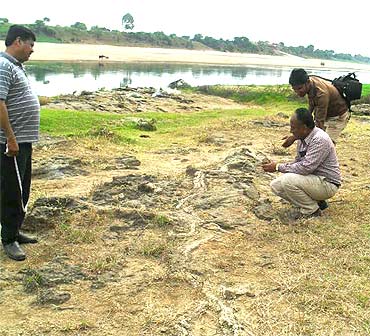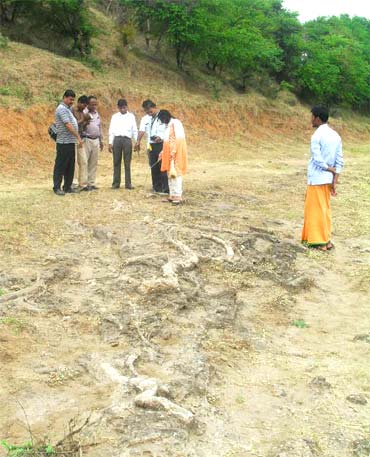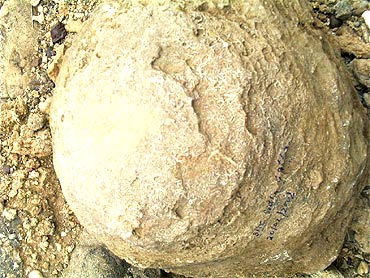Nemicolopterus Crypticus, or 'flying dinosaurs' that were all six feet long, ruled the skies 22 crore years ago.
Some sixty-five crore years after their existence was wiped off the face of the earth, a team of scientists has found the fossilised remains of these winged lizards in Patai village in Madhya Pradesh's Raisen district, near Narmada river.
The team comprising Indian botanists, researchers and archaeologists are elated at their discovery.
"We were stunned and amazed when we came across such a rich treasure trove of unique fossils which can unlock the mystery about animals and plants which existed from the late Triassic to the end of the Cretaceous period (22 crore to 6.65 crore years ago)," said Dr K W Shah, head of the botany department of the Narmada Post Graduation College in Hoshangabad, Madhya Pradesh.
Text: Shuriah Niazi
The winged lizards were 6.5 feet long
Image: Scientists inspect the site where the fossils were foundA similar site with fossils of the toothless mini-pterodactyl, called Nemicolopterus Crypticus, has been found in the western part of China's Liaoning province.
Incidentally, the first dinosaur fossils in India -- the assembled skull of a Rajasaurus Narmadaensis -- were found in Hathnora village in Hoshangabad district, some 95-odd km from Patai village.
Researchers say the discovery of the site offers clues about the distribution of pterosaurs or the 'winged lizard', often referred to as pterodactyls, which existed from the late Triassic to the Cretaceous period in the Narmada basin.
"Impressions of bones, wings and several other body parts in the 6.5 feet long fossilised forms have been found intact here. We believe that the fossils belong to pterodactyls," said research analyst and archaeologist Mohammed Wasim Khan of the Archeological Environment Research and Tribal Welfare Society.
Scientists find 33 fossils at site
Image: Fossilised remains of dinosaur eggs at the siteScientists believe that pterodactyls were the earliest vertebrates who undertook powered flights after developing wings formed by a membrane of skin, muscle and other tissues, which stretched from their legs to a dramatically lengthened fourth finger.
During the field study, the team of researchers discovered 33 fossils spread over an area of 2.5 sq km.
"We have also discovered 42-feet long fossils of some animals, egg shells of dinosaurs, bone impressions of some huge animals and fossils of cycads group of plants that are very primitive in their origin," said Dr Ravi Upadhayay, who teaches at the department of botany at the Narmada Post Graduation College in Hoshangabad.
The site remains under water for six months a year
Image: Scientists inspect the site where the fossils were foundSpeaking on how the fossils remained intact for crores of years, Shah said, "The site remains under water between July and late November. After the water level in Narmada river recedes, the impressions of bones and plants begin to re-appear," said Shah.
The team of researchers has submitted an extensive report to the district administration to preserve the site so that the scientists get an opportunity to gain new, useful insights into the species that took to the skies using their forelimbs millions of years ago.





article